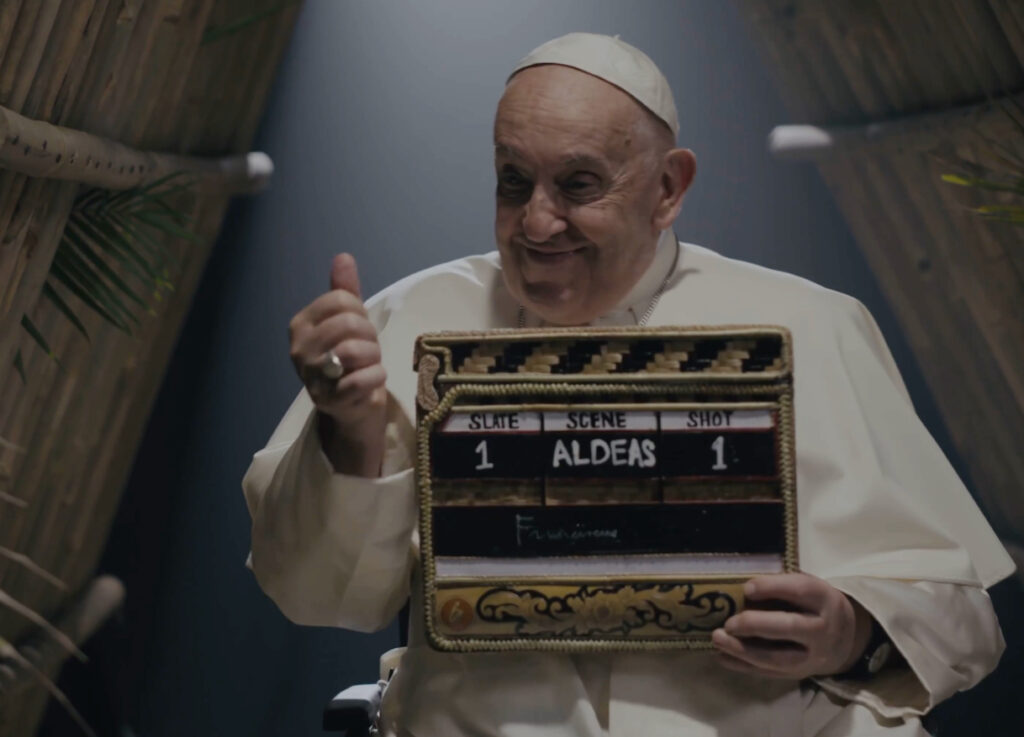Martin Scorsese has never shied away from interrogating the sacred. From the Christ-haunted silence of Mean Streets to the tortured martyrdom of Silence, his work has often danced at the boundary between violence and grace, blood and benediction. Now, in the twilight of an extraordinary pontificate, Scorsese turns his gaze once more to the divine — this time, not through fictional metaphor but through the lens of real-life sanctity. Aldeas — A New Story, a documentary film currently in post-production, features what is believed to be the final long-form filmed interview with Pope Francis. It is both an elegy and a vision: a cinematic reliquary of a man who has shaped the 21st-century Catholic Church through radical humility and spiritual resilience.
Produced by Scorsese in connection with Spanish filmmakers Pablo José Meza and José María Rodríguez, Aldeas frames the Pope not simply as a religious figure, but as a philosophical compass in a world desperately in search of meaning. The project is rooted in the testimonies of global youth — those from rural villages, urban peripheries, and forgotten war zones — who converge through story and question, unified by the hope that their voices still matter. But at the heart of the film is Scorsese’s own encounter with Francis, a conversation that transcends genre to become, in many ways, a spiritual testament.
A PILGRIMAGE IN CINEMA
Shot over several years and incorporating documentary footage, direct interviews, and scripted reconstructions of real events, Aldeas (“Villages”) carries a quiet urgency. It is a film about voices — those of the young, the poor, and the dying — brought into communion with the leader of over a billion souls. This is no mere tribute to papal legacy; it is a probing dialogue about where we go from here.
In their final filmed meeting, Francis, already frail and visibly battling the constraints of age and illness, is portrayed not as a distant ecclesiastical monarch but as a listener — patient, amused, grief-stricken, and at times stunned into silence. He does not lecture. He receives. And it is this receptivity that gives the film its gravity. The Pope, long known for his compassion toward the margins, becomes a kind of sacred cipher, through which the hopes and despairs of the young are filtered, weighed, and blessed.
Scorsese, who met with the Pope privately in 2023 during the Vatican’s World Meeting on Human Fraternity, described the experience as “one of the most profound dialogues of [his] life.” What followed was an extended conversation — sometimes theological, often confessional — about faith, cinema, loss, and the end of things. For Scorsese, whose own work has meditated repeatedly on guilt, penance, and the ambiguity of grace, the film is not merely a production; it is a culmination.
FRANCIS AS STORYTELLER
What’s remarkable in Aldeas is not the pageantry of the Church, but the profound intimacy of Francis as a storyteller. In one segment, he speaks of his early priesthood in Argentina, reflecting on the poverty of the villas miserias and the spiritual instruction he received from the people who lived there. Elsewhere, he recounts the moment he felt the weight of the papacy settle over him “like a stone dropped in water” — a metaphor less about burden than about consequence, the ripples of which continue outward still.
There are no political grandstands or encyclicals here, no sweeping judgments. Instead, Francis talks about the quiet things — what he reads before bed, what he dreams about, what makes him cry. When asked what he fears most, his answer is simple: “Not listening enough.”
The role of listener, a theme that has defined his pontificate, finds full expression in Aldeas. The Pope becomes not an oracle but a witness — someone who offers his attention as a kind of sacrament. This notion dovetails with Scorsese’s own lifelong fixation on moral ambiguity and interior struggle. The filmmaker does not ask for certainty; he asks for presence. And Francis, in turn, offers the full weight of his presence in this final cinematic testimony.
THE SACRED AND THE CELLULOID
Scorsese’s involvement in Aldeas is not simply symbolic. His fingerprints are on the very aesthetic of the film — stark contrasts, long silences, moments of human rupture. A student of Rossellini and Bergman, he has long known that spiritual stories are not told through grand miracles but through small, trembling moments: a gesture of forgiveness, a hand outstretched, a tear shed in silence. Aldeas inherits this legacy.
Visually, the film toggles between the warmth of sunlit villages and the cold corridors of power, between bustling streets in Nairobi and the stillness of the papal residence in Rome. In one particularly affecting sequence, a teenage girl from the Philippines shares her poetry with the Pope. He closes his eyes as she speaks, his lips moving silently in prayer. It is unclear whether he is praying for her, or for the world.
Throughout, Scorsese uses his signature editorial rhythm — allowing moments to linger, voices to echo — but he also steps back. He does not dominate the frame. This is not a Scorsese film in the traditional auteurist sense. It is something closer to a meditation. He acts less as director than as disciple.
A POSTHUMOUS DIALOGUE?
Though Pope Francis has not yet passed, the documentary has already taken on the aura of a final chapter. With his declining health and the looming question of succession within the Vatican, many are treating Aldeas as a kind of farewell address — not just to Catholics, but to the human family. The documentary becomes an archive of a spirit, distilled into frames.
Scorsese, no stranger to mortality, seems acutely aware of this. “It’s not a film about death,” he reportedly told crew members, “It’s a film about what death asks of the living.” That insight threads the film with a sober but luminous energy. Even as Francis speaks of endings — of his own, of institutions, of the planet — he does so with the curiosity of someone still very much alive to the mystery of things.
And that is perhaps the most moving aspect of Aldeas — its insistence that conversation, even when facing the void, remains holy.
BETWEEN FAITH AND FICTION
For decades, Scorsese has explored characters who exist between worlds — between sin and salvation, between the streets and the sanctuary. In Aldeas, he finds in Pope Francis a man similarly caught between paradoxes. A pontiff who rides in a Ford Focus, a theologian who welcomes atheists, a global authority who insists on being called “brother.” It is this radical humility that the film elevates into myth — not by exaggerating it, but by presenting it plainly.
Francis is not lionized. He is not framed as perfect. He is shown forgetting names, struggling with hearing, making jokes that fall flat. At one point, he admits to being “tired of being symbolic.” Yet it is this very vulnerability that gives Aldeas its sacred character.
In Scorsese’s earlier work, faith is often something brutal and lonely — a cross to be carried rather than a song to be sung. But in Aldeas, we see another possibility. Faith here is a shared language. It is spoken across barriers of age, geography, and doctrine. And it is built not on certainty, but on the courage to keep asking questions — even when the answers never come.
THE LEGACY OF A DIALOGUE
With Aldeas — A New Story, Martin Scorsese has created more than a film. He has constructed a living dialogue — one that will outlast both its subjects. As viewers, we are invited not only to observe, but to participate. We are asked to listen, to reflect, and perhaps, to begin our own conversations with whatever is sacred in our lives.
Pope Francis once said, “Reality is greater than ideas.” This film takes him at his word. It does not offer dogma or doctrine. It offers stories. Wounds. Laughter. A final interview that feels like a benediction.
In one of the final scenes, a young boy from Syria asks the Pope if he still believes the world can change. Francis smiles. He does not answer quickly. He closes his eyes and says softly: “Only if we change how we see each other.”
And then the screen fades.
No comments yet.








